In June, advocates hoping to strike down President Donald Trump’s executive order on birthright citizenship, among other executive branch actions being challenged by an array of plaintiffs, received some unwelcome news from the Supreme Court. Universal injunctions — by which a federal district court in one jurisdiction can temporarily prevent a government policy from being enacted everywhere in the country — are generally impermissible, the Court said.
But the justices did keep the door open to another option for nationwide relief: the class action lawsuit. And that part of Trump v. CASA, when paired with another emergency — or “shadow” — docket case from the past term, might add up to an unexpected boon for opponents of the president’s policy agenda, says William B. Rubenstein ’86, the Bruce Bromley Professor of Law at Harvard Law School.
That second and less noticed emergency docket decision, Rubenstein says, is A.A.R.P. v. Trump, issued in May. The case involves a lawsuit against the Trump administration’s effort to deport alleged Venezuelan gang members under the Alien Enemies Act. The case was filed as a class action but had not yet been certified to proceed as one when emergency relief was provided to the entire class. In its short opinion, the Supreme Court in that case allowed temporary relief blocking the policy’s implementation for the full class while the lawsuit is being litigated.
Specifically, buried within the unsigned opinion was a key passage. Citing a treatise written by Rubenstein, an expert in representative litigation, the Court held that although the lawsuit challenging the deportations had not yet been certified, or approved, as a class action, the lower court could still block the policy for the whole class.
This was a bigger deal than some might realize and, when read with Trump v. CASA, makes class action lawsuits even more appealing for opponents of federal policy, says Rubenstein.
“That sentence is an enormous assistance to the plaintiffs challenging all the Trump administration policies,” he says. “It literally relieves them of having to deal with class certification proceedings at the temporary relief phase of the lawsuit.”

In other words, class action plaintiffs still might be able to at least temporarily prevent a federal policy from going into effect against everyone in the nation, even as the Court rejected the widespread use of universal injunctions.
Class action lawsuits enable a designated plaintiff or plaintiffs to represent a larger group of people who have suffered similar harms. Although class actions are often associated with the world of business and commerce — a way to hold companies liable for data breaches, harmful products, or defective medical devices — they have also been used to vindicate civil rights, such as in the landmark case Brown v. Board of Education challenging school segregation.
Traditionally, to receive emergency — or temporary — relief while a class action lawsuit plays out in the courts, some courts went through full process of certifying the class, Rubenstein says. This can take a long time — weeks, even months or years, he says —because the judge must ensure that members of the alleged class are sufficiently similar enough to justify being joined together and, if they are, that the plaintiff is an appropriate representative for the group.
But sometimes, people don’t have that kind of time.
“If I’m facing deportation and I have to wait until the court processes run to get my relief, the government may have deported me by then, and the whole case might be moot,” he explains. “Sometimes parties need relief at the beginning of the case just to hold the status quo in place so that there’s relief to be given at the end.”
The Supreme Court’s holding in A.A.R.P. is especially significant, Rubenstein says, given its decision in Trump v. CASA.
“In CASA, the Court said that emergency relief can only be as broad as the parties to the case,” he says. “So, the thinking now is, Ok, if I bring a class action, the parties to the case can be everybody in the country impacted by the policy.”
Rubenstein says that the powerful modern-day class action lawsuit is possible because of a rule change that happened in 1966. “Up until that time, absent class members had to opt in to a class action.” Today, representative litigation is opt-out, which “made the tool much more meaningful as a litigation technique.”
What has been somewhat unclear, though, is whether courts could give temporary relief to the full class before the class certification process is done, thanks to the Court’s opinion in A.A.R.P., Rubenstein says, it is now clear that a court can do so.
“A.A.R.P. was a short decision, but it was also 7-2 on this point. It’s a fairly strong precedent,” he says.
Still, not all the justices were happy. Rubenstein notes that, in Associate Justice Samuel Alito’s dissent from the majority opinion in the case, he argued that a court should not grant relief until the class certification process has concluded.
“The idea of due process means that typically, courts don’t order parties to do something or not do something until the end of the case,” Rubenstein explains. “Justice Alito’s dissent was focused on how much a court has to do to certify a class in providing relief to a class before the end of the case.”
Given the tension between the need for emergency relief in some cases and the time needed for class certification proceedings, Rubenstein predicts there will be a lot of litigation in the coming year over the scope of the Court’s holding in A.A.R.P. “The Court used the phrase ‘temporary relief’ so one question will be whether than encompasses both temporary restraining orders, which are of short duration, and also preliminary injunctions, which are also temporary relief but for a longer duration. Courts will also have to consider the relationship between CASA and A.A.R.P.
For now, he says the Court’s holding in A.A.R.P. will significantly benefit opponents of the administration — at least in the early stages of the lawsuit.
“If that question makes its way back up to the Court again in the coming years, we’ll see what happens,” he says. “But for the time being, it’s the law of the land.”
Rubenstein also cautions that, even if plaintiffs obtain early relief, that doesn’t mean they will ultimately prevail in blocking a policy forever. For one thing, advocates will still eventually have to prove that class certification makes sense, and that can be difficult.
“Are the class members really all similarly situated? Aren’t there differences in x, y, z? It can get very complicated, though historically, class certification is pretty straightforward in cases that simply challenge the constitutionality of a government policy on behalf of everyone impacted by it,” he says.
Want to stay up to date with Harvard Law Today? Sign up for our weekly newsletter.
